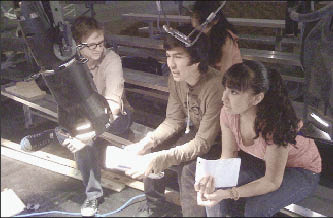 |
|
Academics and stagecraft: Students carry a full academic load and concentrate in their field of interest: music, visual arts, film, dance, theater or musical theater. Photo: Los Angeles High School of the Arts |
Los Angeles – In many school districts across the United States, ninth-graders must either enroll in vocational-technical courses or commit themselves to a traditional academic, college preparatory program.
Not in California.
“It is no longer a matter of either-or – college or career,” said Gary Hoachlander, president of ConnectEd, a nonprofit organization that encourages California educators to offer all students a rigorous academic program combined with technical training in professions that can provide employment after graduation. Known as “linked learning” and backed by business leaders and the James Irvine Foundation, California first embraced the concept in 1984 and now 12 percent of the state’s high schools offer it. Linked learning is also being tried in other states, such as Florida.
Last month, the California Department of Education released a report endorsing the linked learning model as one that prevents many kids from dropping out of high school and encourages them “to remain in the game until they cross their own personal goal line, whether it’s college, a profession, or a good job you can raise a family on.” The state legislature mandated the report two years ago to determine the feasibility of expanding linked learning – then known as Multiple Pathways – to more schools.
 |
|
Action-based projects; Scaled-down productions allow students to work through problems that an adult professional might face. Photo: Los Angeles High School of the Arts |
“Linked learning is a promising approach to transforming our high schools so students graduate career- and college-ready and ready to be successful in the global economy of the 21st century,” declared California Superintendent of Public Instruction Jack O’Connell. “Linked learning is a way to remove what is a false and faulty separation between academic and career preparation. Our students need both if they are to succeed.”
The report said students in linked learning programs are more likely to pass the California High School Exit Examination, to graduate from high school and to complete college entrance requirements. It recommended a number of fundamental changes in California law that will enable more school districts to adopt the model.
According to Hochlander, one of the primary functions of linked learning is to demonstrate the importance of academic theories by showing students how those theories are applied in the real world. He said many students better understand algebra, for example, when they are using it to calculate how many sacks of cement will be needed to build the foundation of a building.
Not all of the linked learning programs were established in the same way. ConnectEd, which was created by the Irvine Foundation, has been providing support for at least 16 different programs in the state. A similar model is being used in about 340 so-called California Partnership Academies that receive up to $81,000 per year from the state, as well as local community support. Each school focuses on one of 15 industries in the state, and often uses industry veterans as instructors. The chosen career fields include health sciences, engineering, architecture, construction, digital media, animation and theater.
Here in Los Angeles, linked learning is a part of a massive effort to improve failing local high schools, where the dropout rate hit 75 percent before these reforms were initiated. School Board President Monica Garcia said the program has been essential in remaking Belmont High School, which was once the largest public school in the United States, with 5,600 students. With considerable assistance from leaders of the business community and the surrounding Latino neighborhood, the Belmont school population was broken into smaller learning communities that are much more successful at engaging students. Garcia described Belmont as “the cradle of reform in the Los Angeles Unified School District.”
Both the Chamber of Commerce and the Alliance for a Better Community, a local Latino civic group, played a part of the planning at Belmont. David Rattray, president of UNITE-LA, who represents the Chamber of Commerce, even has located his office across the street from Belmont’s sprawling urban campus a mile west of downtown Los Angeles.
“Linked learning overcomes student boredom, and student boredom is the main reason for dropping out,” said Veronica Melvin, executive director of Alliance for a Better Community. “Schools cannot do it alone anymore.”
Students can choose to attend any of the separate schools at Belmont, which is why they call it the “Zone of Choice.” But selecting a linked learning school dedicated to the performing arts, for example, does not necessarily mean the student is committed to going into that field upon graduation. Sidronio Jacobo, who will enter the University of California at Berkeley in the fall to study political science or public policy with a goal of attending law school, never planned to work in the theater, even though he is graduating from a performing arts school. He said he chose the performing arts curriculum because his sister recommended it, and the curriculum “helped me to articulate my ideas.”
Despite many success stories, critics fear linked learning eventually will become nothing more than window dressing on a conventional trade school education. Hochlander acknowledged that it is sometimes difficult to sustain rigorous academic courses in schools populated primarily by low-income students.
The students and teachers at Los Angeles High School of the Arts, which was first established in 1998 as the Belmont Academy of Performing Arts, were forced back into the general high school population for a year when Belmont got a new principal in 2005. “He didn’t understand what we were doing,” said arts teacher Tara J. Pearson.
“This happens all the time,” admitted Hochlander. “One of the biggest worries is the sustainability of schools like LAHSA.”
To help sustain these programs, Hochlander explained, ConnectEd is supporting continuing education programs for teachers on six California university campuses to show them how to run linked learning schools.
Proponents of linked learning say it works because it allows students to make their own choices, which is a rare option in low-income areas. As one report funded by ConnectEd observes, “They will have the ability to choose their own path, not have it chosen for them because of poor academic performance, inadequate preparation for college or a lack of relevant workplace skills.”
Resources: http://www.connectedcalifornia.org. Read the report Multiple Pathways to Success at http://www.schoolsmovingup.net/mpstudy/downloads/Final_Chs_1-15_051210_FINAL_v2.pdf.






























